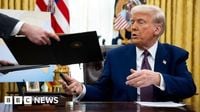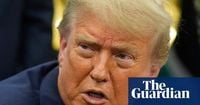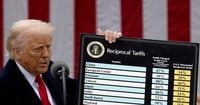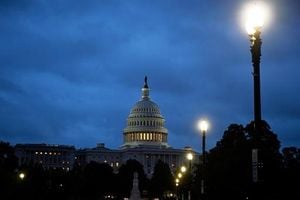On August 29, 2025, a federal appeals court delivered a seismic jolt to President Donald Trump’s trade agenda, ruling by a 7-4 margin that most of his signature tariffs on imports are unlawful. The decision, which reverberated through Washington and global markets alike, found that Trump had overstepped his presidential authority by imposing sweeping levies on nearly every country trading with the United States—a move that had defined the economic landscape of his second term and rattled international partners since the so-called "Liberation Day" announcement in April.
The ruling specifically targets the "reciprocal tariffs"—including a 10% flat rate on imports from most countries and rates as high as 50% on select nations such as India and Brazil—rolled out on April 2, 2025. It also covers the "trafficking tariffs" imposed on February 1 against China, Canada, and Mexico, justified by the administration as a response to those countries’ alleged failure to stem the flow of fentanyl and other drugs into the U.S. Notably, tariffs on steel, copper, and aluminum remain unaffected, as they were enacted under a different legal authority.
At the heart of the court’s decision is the International Emergency Economic Powers Act (IEEPA), a 1977 law designed to give presidents tools to address "unusual and extraordinary threats" from abroad. Trump had invoked the IEEPA, arguing that the U.S. trade deficit constituted a national emergency threatening national security. However, the appellate judges found this justification wanting. "The core Congressional power to impose taxes such as tariffs is vested exclusively in the legislative branch by the Constitution," the court stated, emphasizing that the IEEPA "did not give the president wide-ranging authority to impose tariffs." According to the judges, tariffs are a classic Congressional prerogative, and the law in question "neither mentions tariffs (or any of its synonyms) nor has procedural safeguards that contain clear limits on the president's power to impose tariffs."
The decision echoes a similar ruling from the U.S. Court of International Trade in May, which also rejected Trump’s argument that his global tariffs were permitted under emergency economic powers. The court’s stance is clear: while the president can wield significant authority in response to national emergencies, that authority does not extend to imposing broad, unilateral taxes on imports.
For Trump and his supporters, the verdict is a bitter pill. The tariffs, which at their peak affected nearly 69% of U.S. goods imports, had been a cornerstone of his promise to eliminate trade deficits, end what he called unfair trading terms, and bolster American jobs. Trump’s reaction was swift and characteristically forceful. Taking to Truth Social within hours of the ruling, he declared, "ALL TARIFFS ARE STILL IN EFFECT!" He lambasted the court as "highly partisan" and warned, "If allowed to stand, this Decision would literally destroy the United States of America." He added, "We should all remember that TARIFFS are the best tool to help our Workers, and support Companies that produce great MADE IN AMERICA products." Trump vowed to take the fight to the Supreme Court, writing, "Now, with the help of the United States Supreme Court, we will use them to the benefit of our Nation, and Make America Rich, Strong, and Powerful Again!"
Despite the ruling, the tariffs remain in effect until October 14, 2025, as the court provided the government a window to appeal. This grace period sets the stage for a high-stakes legal showdown at the Supreme Court, which could have far-reaching implications for presidential power, Congressional authority, and the future of U.S. trade policy. The conservative-leaning Supreme Court, with six of nine justices appointed by Republican presidents (including three by Trump himself), could be sympathetic to the administration’s arguments. Yet, in recent years, the Court has also shown a willingness to curtail executive overreach, as seen in its application of the "major questions doctrine" to strike down policies not explicitly authorized by Congress.
The uncertainty unleashed by the ruling is already making waves in the economy. As reported by BBC and other outlets, businesses are grappling with unpredictability, and many are unsure how to proceed with international contracts. Dr. Linda Yueh, an economist at Oxford University and the London Business School, told BBC Radio 4, "Businesses are going to be subject to uncertainty." This climate of doubt could, in her view, "dampen down economic activity" as companies and trading partners wait for the Supreme Court’s next move.
The impact on consumers has been immediate and tangible. The U.S. wholesale price index jumped in July, and major retailers such as Walmart and BestBuy have already raised prices on many imported goods, citing the higher costs imposed by the tariffs. With the fate of the levies in limbo, many expect further price increases in the months ahead. If the Supreme Court ultimately strikes down the tariffs, there could be additional headaches: questions loom over whether the government would need to refund billions collected in import taxes, and whether previously negotiated trade deals with countries like the UK, Japan, and South Korea would remain valid.
Meanwhile, parts of Trump’s tariff strategy remain insulated from the court’s decision. Sector-specific tariffs on steel and aluminum, enacted under Section 232 of the Trade Expansion Act, are not affected by the recent ruling. According to CNBC, the Trump administration has even expanded these tariffs to cover over 400 additional product categories in recent months. Legal experts, such as Mike Lowell of Reed Smith, note that these sector-specific measures are more likely to survive judicial scrutiny and continue into the next administration. The elimination of the "de minimis" exemption—meaning imports valued at $800 or less are now subject to duties—also remains untouched, dealing another blow to small and medium-sized businesses.
As the October deadline approaches, both domestic and international markets will be watching closely. The possibility of a Supreme Court reversal, which would restore the president’s ability to impose sweeping tariffs under emergency powers, could set a precedent for future administrations—potentially emboldening them to take even broader action on trade or other economic issues. Conversely, if the Court upholds the appeals court’s decision, it would reinforce Congressional primacy in matters of taxation and trade, and mark a significant curtailment of executive authority.
The political stakes are no less dramatic. For Trump, the outcome will either vindicate his approach as a hard-nosed dealmaker or deliver a stinging rebuke to one of his central campaign promises. For Congress, it’s a test of its willingness and ability to assert its constitutional powers in the face of an assertive executive branch. And for American consumers and businesses, the next few months promise continued uncertainty—at least until the highest court in the land weighs in.
For now, the tariffs that have shaped the economic conversation for much of 2025 remain in place, but the clock is ticking on their fate. With legal, economic, and political consequences hanging in the balance, all eyes are on the Supreme Court—and the next chapter in America’s ongoing trade wars.






